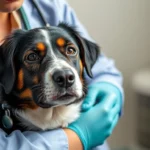
Introduction
Cancer in dogs is a term that often strikes fear into the hearts of pet owners. This complex disease can take many forms and affect dogs of all ages, sizes, and breeds. Understanding cancer is crucial for dog owners, as it empowers them to recognize symptoms early, seek appropriate veterinary care, and make informed decisions about their pet’s health.
Statistics indicate that cancer in dogs is alarmingly common, with research suggesting that nearly 1 in 4 dogs will develop some form of cancer in their lifetime. Certain breeds, such as Golden Retrievers and Boxers, are particularly predisposed to specific types of cancer, while older dogs are generally at a higher risk.
This article aims to educate dog owners about the various aspects of cancer in dogs, focusing on early detection and treatment options.
What is Cancer in Dogs?
Definition of Cancer
In simple terms, cancer is a group of diseases characterized by the uncontrolled growth and spread of abnormal cells. These cells can form tumors, which are classified as either benign or malignant. Benign tumors do not spread to other parts of the body and are usually not life-threatening. In contrast, malignant tumors invade nearby tissues and can metastasize, or spread, to other organs.
Common Types of Cancer in Dogs
Various types of cancer can affect dogs, each with its own unique characteristics. Here are some of the most common:
- Lymphoma: A cancer of the lymphatic system that can affect dogs of any age.
- Osteosarcoma: A type of bone cancer that typically affects larger breeds.
- Mast Cell Tumors: These skin tumors can vary in severity and are more common in certain breeds.
- Hemangiosarcoma: A cancer of blood vessels that often affects the spleen and can be aggressive.
- Melanoma: This type of cancer can develop in the skin or mouth and is particularly aggressive.
Understanding these types can help dog owners recognize potential issues and seek veterinary advice promptly.
Signs and Symptoms of Cancer in Dogs
General Signs of Cancer
Detecting cancer in dogs early can significantly improve treatment outcomes. Common signs to look for include:
- Weight Loss: Unexplained weight loss can be a significant indicator of underlying health issues.
- Loss of Appetite: A sudden change in eating habits may signal discomfort or illness.
- Lethargy: Decreased energy levels or reluctance to engage in activities can be a warning sign.
Specific Symptoms Related to Different Types of Cancer
Recognizing specific symptoms can help pinpoint the type of cancer. For example:
- Lumps or Bumps on the Skin: These may indicate tumors, both benign and malignant.
- Coughing or Difficulty Breathing: These symptoms may be associated with lung cancer.
- Vomiting or Diarrhea: These can be signs of abdominal tumors.
Early detection is key. If you notice any of these symptoms, consult your veterinarian promptly.
Risk Factors for Cancer in Dogs
Age and Cancer Prevalence
Age is one of the most significant risk factors for cancer in dogs. Statistics show that the likelihood of developing cancer increases as dogs get older, with many cancers being more common in dogs over the age of 10.
Breed Predispositions
Certain breeds are genetically predisposed to specific types of cancer. Here’s a list of breeds that are known to have higher cancer risks:
- Golden Retrievers
- Boxers
- Rottweilers
- Bernese Mountain Dogs
- Labrador Retrievers
Environmental Factors
Environmental factors can also contribute to cancer risk. These include:
- Diet and Nutrition: Poor diet can weaken the immune system and increase cancer risk.
- Exposure to Chemicals and Pollutants: Dogs exposed to pesticides, herbicides, and other chemicals may have a higher risk of developing cancer.
Understanding these risk factors can help dog owners take proactive steps to minimize their pet’s cancer risk.
Diagnosis of Cancer in Dogs
Veterinary Examinations
Regular veterinary check-ups are essential for early detection of cancer in dogs. During these visits, veterinarians can conduct thorough examinations and identify any abnormalities.
Diagnostic Tools
If cancer is suspected, several diagnostic tools may be employed:
- Blood Tests: These can reveal underlying health issues and organ function.
- Imaging: Techniques such as X-rays, ultrasounds, and CT scans help visualize internal structures.
- Biopsies: A definitive diagnosis often requires a biopsy to examine tissue samples.
Understanding the Diagnosis Process
Navigating the diagnosis process can be overwhelming. Here’s what you can expect during vet visits:
- Initial Consultation: Discuss symptoms and concerns with your veterinarian.
- Diagnostic Testing: Your vet may recommend tests based on initial findings.
- Follow-Up: Understanding results and discussing next steps is crucial.
Don’t hesitate to ask your veterinarian questions about the diagnosis process. This will help you feel more informed and empowered.
Treatment Options for Cancer in Dogs
Overview of Treatment Modalities
The treatment for cancer in dogs depends on various factors, including the type and stage of cancer. Common treatment options include:
- Surgery: Often used to remove localized tumors.
- Chemotherapy: This systemic treatment can target cancer cells throughout the body.
- Radiation Therapy: This may be used to shrink tumors or alleviate pain.
- Palliative Care: Focuses on comfort and quality of life when curative treatments are not an option.
Factors Influencing Treatment Decisions
Several factors influence treatment decisions:
- Type and Stage of Cancer: Each type of cancer may respond differently to treatments.
- Overall Health of the Dog: A dog’s age and general health can impact treatment options.
Alternative Therapies
Some dog owners may explore alternative therapies alongside conventional treatments. These can include:
- Holistic Approaches: Such as acupuncture or herbal remedies.
- Nutritional Support: A balanced diet can aid in recovery and overall health.
Always consult with your veterinarian before starting any alternative treatments to ensure they are safe and appropriate.
Caring for a Dog with Cancer
Home Care Tips
Caring for a dog diagnosed with cancer in dogs requires special attention. Here are some tips:
- Providing Comfort and Support: Create a calm and comfortable environment.
- Importance of a Balanced Diet: Consult your veterinarian about dietary needs.
Managing Side Effects of Treatment
Many treatments can produce side effects. Here’s how to manage them:
- Nausea: Speak to your vet about medications to alleviate nausea.
- Pain Management: Ensure your dog is comfortable and pain-free.
- Fatigue: Allow plenty of rest and quiet time.
Emotional Support for Both Dog and Owner
Caring for a dog with cancer can be emotionally taxing. Here are some coping strategies:
- Talk About Your Feelings: Sharing concerns with friends, family, or support groups can alleviate stress.
- Stay Informed: Knowledge about the disease can empower and ease anxiety.
Prognosis and Quality of Life
Understanding Prognosis
The prognosis for cancer in dogs varies widely based on several factors:
- Type of Cancer: Some cancers have better survival rates than others.
- Stage at Diagnosis: Early detection can lead to better outcomes.
Quality of Life Considerations
Assessing your dog’s quality of life is crucial. Consider the following:
- Behaviors and Preferences: Take note of your dog’s enjoyment of daily activities.
- Physical Comfort: Ensure your dog is not in pain or discomfort.
Resources for Support
If you find yourself in need of additional support, consider reaching out to:
- Veterinary Oncologists: They specialize in cancer treatment and can provide advanced care.
- Support Groups: Connecting with other dog owners can provide emotional support and shared experiences.
Conclusion
Understanding cancer in dogs is a vital part of responsible pet ownership. Recognizing the signs, knowing the risks, and being informed about treatment options can significantly impact your dog’s health and quality of life. Regular veterinary visits and immediate attention to any concerning symptoms are essential for early detection and effective management.
Staying informed and proactive can make a world of difference for you and your furry friend.









